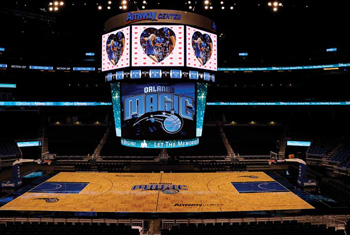Adding Services And Training Revenue To Digital Signage
The digital signage at Amway Center, managed via a Harrisbuilt control room, presents a consistent look and feel to deepen the impact of brand messaging and announcements.
That digital sign at the bank, clothing store, or favorite neighborhood bistro doesn’t stop us in our tracks anymore. As signage blends into the everyday landscape, AV integrators must navigate the waters of competition, solution choices, infrastructure, and market segments to be well positioned in the game.
To succeed in the realm of digital signage, integrators must understand the nuances of multiple solutions, said Vince Faville, digital signage business development manager for Advanced AV in West Chester, PA. “Clients have either heard the term digital signage or they just know they want to send messages around their facilities,” he said. “They may not know which solution they’re looking for or how it works, and this is where we come in. We offer from 12 to 20 applications, and in that sense we work as consultants as well as integrators. The first step is to sit down with our clients and give them demos of various solutions from A to Z. If A doesn’t work for their needs, we can easily go to B; every client is different. Some dealers depend on specific manufacturers; we prefer to evaluate and demo all the products that we sell that might be the best fit. It’s an investment in client confidence and we show solutions without bias. In the end, what is important is that we have provided the right solution to meet their needs.”
About 80 percent of Advanced AV’s digital signage clients are in the corporate and higher education market. “That’s also where we see the most growth,” he said. “Corporate lobby installations typically are for messages about meetings, stock information, and a first impression welcome message. Universities want to get the message out about what’s happening on campus. They frequently have satellite campuses and use signage as a way of making sure that satellite students are included in the information as well.
“Scheduling displays have shown continued growth,” Faville said. “Both corporations and schools benefit from room scheduling signage. We’re having success in putting small LCD displays outside classrooms and conference rooms, integrated with Outlook or any scheduling software that has calendars. So if a class is moved or if someone wants to book a room, the information is available. This is a very popular function and as more clients become aware of it the more popular it becomes.”
Digital signage is an evolving technology, he said. “Take signage output as an example. A few years ago, final outputs all had various formats. Now the formats are all consistent, the difference is how you get it up onto the display. Creation software is where differences are highlighted. Certain software packages allow you to create content within the software and post it directly to your display. There is also the option to create content in a third party software program and import it into the signage system. One system isn’t necessarily better than another. It all depends on the client’s workflow.”
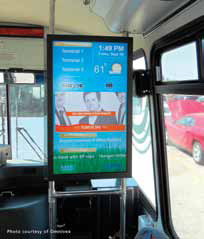
Omnivex Corporation deployed its Moxie software on Destination Shuttle Service’s airport shuttle buses at LAX. The Shuttle Smart deployment also includes interactive kiosks placed in the lobbies of Destination Shuttle Service’s partner hotels. Using Omnivex Moxie software and Microsoft Windows 7 location based services, GPS coordinates are sent via cellular network to the Omnivex server in real time indicating the current location of the bus.
The Wall
“We’re seeing video walls becoming increasingly popular for digital signage applications,” said Steve Seminario, senior director of product marketing for video wall business at Planar Systems. “The technology has advanced in such a way that implementation of video walls is a simple, easy to service, and a cost effective way of producing a large digital signage display. Our Clarity Matrix LCD family of products is intended to tile together into any size video wall. In digital signage markets such as airports, and retail and public venues, demand has been on the rise.”
Planar Systems’ digital signage solutions have been installed in airport baggage claim settings where a convex-shaped tile wall provides flight information and streamed content such as weather information or advertising. “We have also seen traction in the hospitality market, corporate settings, and even on university campuses for student unions, dorms, and other public spaces,” he said. “These video walls often are used for information presentation, entertainment, and emergency notification.”
Network considerations are increasingly important. As multimedia content becomes increasingly dynamic, bandwidth and network security parameters become critical factors for consideration. “Today’s digital signage content management solutions do a good job of mitigating those potential issues,” Seminario said. “In a university student union environment for example, one portion of the video wall may show daily menus, so it has to be easy to update that content locally. At the same time, you might want a live CNN feed as well as a scrolling list of campus events. On top of that event management system may be a function to override the system and send out campus wide alerts in cases of emergencies.”
Digital signage software allows this to be done easily with a great deal of flexibility, he said. “But if you imagine such a video wall environment, the salient questions for integrators are: What impact will this have on my network bandwidth, and am I opening my network up to security vulnerabilities?”
Multi-Point Thinking
With growing competition and lower margins for hardware, integrators have to take advantage of new possibilities in infrastructure backbones and service contracts, said Paul Seiden, director of sales, Communications Specialties.
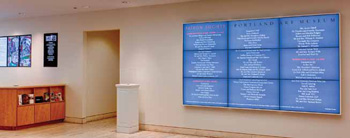
Development staff at the Portland Art Museum found a more dynamic way to recognize the institution’s supporters via a Clarity Matrix LCD Video Wall System by Planar Systems, which showcases museum supporters’ names on an electronic canvas. The 3x3 configuration of 46-inch displays was installed by Portland’s Mtek Kiosk.
“Were seeing big companies such as Cisco entering the market, trying to stream video over IP, setting up networks, and then also handling digital signage to all displays,” he said. “They’re an interesting player, and this is a way for them to expand. But it has an impact on small server manufacturers for digital signage, especially those making handheld products.”
That signage is becoming ubiquitous is a moot point. Seiden notes that even a gas station near his home provides digital signage, with local and national news feeds, on each pump. “Reports show that signage increases profit margins with content on specials in fast-food chain restaurants [see menu boards sidebar] and in retail.”
There’s a growing trend in combining fiber and Cat-5 in large venues with varying configurations, Seiden said. “We were involved in the Lucas Oil Stadium project, which included fiber, and they do a tremendous amount of signage including in their club seating areas with video walls. To go these long distances, from end to end, it’s better to use fiber and to install Cat-5 to local rooms.”
Communications Specialties partners with MagicBox, a manufacturer of digital servers, in university and military installations. “Military projects, with signage alerts and deployments, have to be done with fiber for security reasons,” he said. “Transportation venues, such as the London tube system which we worked on, are fast-growing segments as well, using fiber at every station stop and Cat-5 within the terminal.”
Point A to point B thinking has given way to a multi-point approach, with an LCD, for example, on each floor of a building, perhaps near an elevator, all emanating from one server on the ground floor. “In an arena or a shopping mall, the system can be a multi-point or drop-andrepeat mode, and that has enhanced the growth,” Seiden said. “There are lots of ways that technology has advanced in copper and fiber to create more opportunities, even in theme parks. Integrators just have to be open to exploring these opportunities.”

X2O Media’s Xpresenter digital signage platform keeps guests informed about conferences, training, and performances at the newly opened Kinnear Centre for Creativity & Innovation (KCCI) at The Banff Centre in Alberta, ON, Canada. Applied Electronics Limited installed 26-inch landscape digital screens outside each of the Kinnear Centre’s 19 conference rooms and 42-inch portrait digital displays at its three main entrances.
Everyday Scenes
“Growth in digital signage goes across the board, beyond advertising and promotion and into dissemination of information and education,” said Scott Hetzler, president of Contemporary Research. “We see it being used by school, government, and corporate facilities, hotels, sports bars, as well as in retail where store TV monitors promote product and services.”
With digital signage over coax cable TV, it’s just another channel. “That’s the beauty of it,” Hetzler said. “We take advantage of the digital tuner built into all the new TVs, using it as the HD signage decoder. It’s infinitely expandable and it’s easy to amplify and split the cable periodically to however many TVs you want to carry your signals. I especially like our technique, with only one signage player for the whole facility. You don’t need a signage player/decoder at every display; you take just one and feed it into a QMOD-HD channel modulator. You can mix and match HD signage channels with any combination of other digital and analog channels all on one cable as long as they’re not in the same physical channel frequency space. Our approach allows us to add live broadcast and other channels to the mix, using the TVs not just for signage. You can have CNN, ESPN sports, and a live camera broadcast, and switch them on the fly. You can get two HD channels in each of 135 for at least 270 full HD channels on one broadband cable, all there, all the time. Coax cable TV is the biggest HD pipeline, and without the IT network headaches.”
The best examples of signage are in Las Vegas, he said. “They’re always pushing the promotion envelope, despite the economy. Signage has filtered down to the local worship market, to the local Walgreens drugstore, and to restaurants such as the Pei Wei chain that are using it for dynamic menus. The next big thing in digital signage is more of it. It will become increasingly prevalent all around us.”
Karen Mitchell is a freelance writer based in Boulder, CO.
Margin Builder
Integrators are trying to sell digital signage service contracts and training, as it’s hard to make larger margins on hardware. “They must explore areas other than selling displays,” said Paul Seiden, director of sales, Communications Specialties. “The drop in LCD cost is dramatic; it has dropped so much that it has expanded the signage market. But as price decreases, integrators can’t make much in margin, so they need to find other ways, including infrastructure such as fiber, Cat-X transmitters, receivers, and accessories such as cabling.”
Five-Star Service
Located in Research Park, the center of entrepreneurship and innovation at the University of Illinois in Champaign-Urbana, I Hotel and Conference Center is a contemporary convention-class hotel featuring 120 rooms and suites. Detail is the hallmark of I Hotel, so when I Operations, the company managing I Hotel, sought to upgrade the performance of the digital signage in its hallways and meeting room foyers, it looked for the very best in both equipment and installation. Its first step was to contact C.V. Lloyde, a local vendor and one of the Midwest’s premier commercial AV equipment providers.
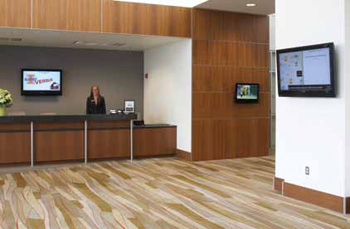
The I Hotel uses Black Box’s iCOMPEL to create dynamic, multi-purpose displays.
“I Hotel has a total of 23 video displays, and was looking for greater flexibility and reliability from all the devices,” said Stephen Morris, president of C.V. Lloyde. “The screens themselves performed well, but the CMS software offered limited functionality and the media players were failing at an inordinate rate for such a young system.”
C.V. Lloyde believed that a best-in-class content management system for I Hotel would provide not only performance improvements, but also new opportunities to delight guests and even increase revenue. Its search led it to the Black Box iCOMPEL digital signage media player.
iCOMPEL can combine video or live TV with scrolling text, photos, Flash, and web content to create dynamic, multi-purpose displays that serve multiple needs. “We realized that the I Hotel staff could significantly increase the value of its displays using iCOMPEL,” noted Morris. “In addition to news feeds, weather widgets, conference agendas, and such, conferences could broadcast meeting activity outside their meeting rooms and wedding parties could run photo montages. At the more tech-savvy events, the hotel could even set up scrolling chats and Twitter feeds from attendees.”
C.V. Lloyde proposed a redesign of I Hotel’s digital display system that would replace the existing 23 media player units with 23 iCOMPEL subscribers and one iCOMPEL Publisher all located in a central management suite. Located behind each display, a Black Box HD receiver gets its signal via Cat-6 from a corresponding rackmounted Black Box HD View Transmitter and iCOMPEL subscriber located in the management suite.
“The centralized, rack mounted configuration keeps all future troubleshooting out of the public areas of the hotel,” said Morris. “Throughout the install, we never had a screen out of service—an important issue for a conference center.”
Morris also pointed out the advantages of the integrated iCOMPEL hardware and software. “iCOMPEL simplifies deployment as well as training,” he stated. “We made sure that every hotel technician had individual instruction on how to use the iCOMPEL system.”
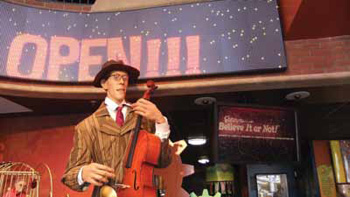
In addition to the BrightSign-driven synchronized video walls in the San Francisco Ripley’s Believe It or Not! entrance, there are new video and image-zoned displays explaining the unique features about exhibits throughout the museum.
Seeing Is Believing
A total of 72 BrightSign solid-state digital media controllers are being used by Ripley Entertainment to deliver compelling exhibit displays in six of its Ripley’s Believe It or Not! Museums. The museums include the recently reopened San Francisco Ripley’s Believe It or Not! Odditorium, where 25 new BrightSign digital media controllers were added as part of a $5 million renovation.
Used to make the exhibits more entertaining and more informative for visitors of all ages, BrightSign HD210 and HD410 players deliver looping HD video displays while HD810s provide playback for interactive displays.
“Reliability and playback of the highest quality were key factors in selecting Bright- Sign, but we also needed a solution that was easy to install and easy to use,” said Louis Aguila, IT analyst at Ripley Entertainment.
BrightSign’s BrightAuthor software also meets Ripley’s requirements for easily creating interactive exhibit displays with unique triggers for display playback and LED lighting controls. BrightSign’s built-in General Purpose Input Output (GPIO) port allows Ripley’s to incorporate button controls, levers and motion sensors to engage their visitors with the interactive exhibits, while the USB port allows for support of more traditional interactivity such as touchscreens and mice.
Signage Magic
by Kirsten Nelson
As official technology partner for the new Amway Center in Orlando, FL, Harris Corporation is helping to enhance customer engagement through dynamically integrated digital signage, IPTV, and HD video production and distribution technology. Combining IPTV and digital signage over the same network allows the Magic to address more than 1,100 individual screens located throughout the arena with tailored content. “This was really about integrating all the systems together and customizing content so that fans feel like they’re actually recognized by the stadium,” noted Denise Mac- Donell, general manager, digital signage at Harris.
The digital signage displays at Amway Center do more than impart information, MacDonnell continued, “As consumers walk through the arena, they will see promotions and advertisements for the part of the arena they happen to be in.”
From the parking garages to the luxury suites, the digital signage at Amway Center presents a consistent look and feel to deepen the impact of brand messaging and announcements. But the technology goes beyond appearances into real smarts. “Integration-wise, our systems are tied into all the other component systems within the facility, including point of sale systems, so it’s possible to change pricing and promotions in restaurant and retail areas and connect sales data to the types of promotions they’re running.”
The digital signage palette at Amway Center is huge. In addition to the center-hung Daktronics scoreboard and LED ribbons snaking around the arena, more than 1,100 video displays were installed throughout the facility by Professional Communications Systems of Orlando, FL.
The network that drives all technology in the Amway Center is managed via a Harris-built control room featuring more than 800 broadcast devices. Almost 75 miles away, employees at Harris headquarters monitor the network 24/7 via a Network Operations Center to ensure fans experience no interruptions during events. The system’s low latency enables content on the screens to be changed during the event and updated to the network with no interruption to the screen information/ graphics or live action.
